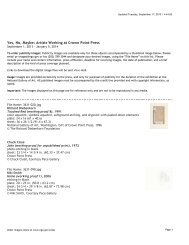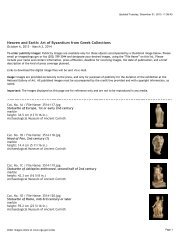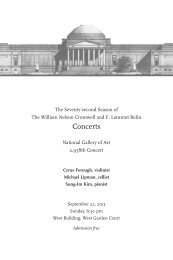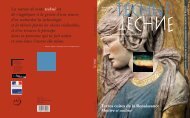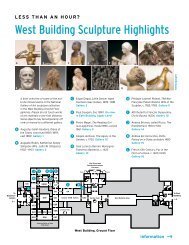2011 Annual Report - National Gallery of Art
2011 Annual Report - National Gallery of Art
2011 Annual Report - National Gallery of Art
Create successful ePaper yourself
Turn your PDF publications into a flip-book with our unique Google optimized e-Paper software.
Social Security Retirement System and<br />
the Federal Employees’ Retirement System<br />
(FERS). Employees hired prior to January 1,<br />
1984 had the option <strong>of</strong> remaining under the<br />
Civil Service Retirement System (CSRS) or<br />
electing FERS. All employees have the<br />
option to make tax-deferred contributions to<br />
a Thrift Savings Plan and, in some instances,<br />
receive a matching portion from the <strong>Gallery</strong>.<br />
The <strong>Gallery</strong> funds all retirement contributions<br />
on a current basis, and accordingly<br />
there are no unfunded retirement costs<br />
(see Note 14).<br />
SFFAS No. 5 also requires that the <strong>Gallery</strong><br />
recognize a current-period expense<br />
for the future cost <strong>of</strong> post-retirement health<br />
benefits and life insurance for its employees<br />
while they are still working. The <strong>Gallery</strong><br />
accounts for this expense in its financial<br />
statements in a manner similar to that used<br />
for pension expense, with the exception<br />
that employees and the <strong>Gallery</strong> do not<br />
make current contributions to fund these<br />
future benefits.<br />
IMPUTED FINANCING SOURCES<br />
In certain cases, the operating costs <strong>of</strong> the<br />
<strong>Gallery</strong> are paid out <strong>of</strong> funds appropriated<br />
to other Federal agencies. As an example,<br />
the law requires certain costs <strong>of</strong> retirement<br />
programs to be paid by OPM and<br />
certain legal judgments against the <strong>Gallery</strong><br />
to be paid from the Judgment Fund<br />
maintained by Treasury. Costs that are<br />
identifiable to the <strong>Gallery</strong> and directly<br />
attributable to the <strong>Gallery</strong>’s operations are<br />
paid by these Federal agencies.<br />
FAIR VALUE MEASUREMENTS<br />
Accounting Standards Codification (ASC)<br />
Topic 820, “Fair Value Measurement and Disclosures,”<br />
defines fair value as the exit price<br />
that would be received to sell an asset or<br />
paid to transfer a liability in the principal or<br />
most advantageous market in an orderly<br />
transaction between market participants on<br />
the measurement date. The standard establishes<br />
a fair value hierarchy that prioritizes<br />
the inputs to valuation techniques used to<br />
measure fair value (see Note 17). The hierarchy<br />
consists <strong>of</strong> three broad levels:<br />
Level 1 - Valuations based on unadjusted<br />
quoted prices in active markets for identical<br />
assets or liabilities that the <strong>Gallery</strong> has the<br />
NATIONAL GALLERY OF ART 55<br />
ability to access as <strong>of</strong> the reporting date. Valuation<br />
adjustments and block discounts are<br />
not applied to Level 1 securities. Since valuations<br />
are based on quoted prices that are<br />
readily and regularly available in an active<br />
market, valuation <strong>of</strong> these securities does<br />
not entail a significant degree <strong>of</strong> judgment.<br />
Level 2 - Valuations based on quoted<br />
prices in markets that are not active or for<br />
which all significant inputs are observable,<br />
either directly or indirectly as <strong>of</strong> the<br />
reporting date.<br />
Level 3 - Valuations based on inputs<br />
that are unobservable and significant to<br />
the overall fair value measurement as <strong>of</strong><br />
the reporting date. The determination <strong>of</strong><br />
fair value for these financial instruments<br />
requires one or more inputs subject to significant<br />
management judgment or estimation.<br />
As <strong>of</strong> September 30, <strong>2011</strong> and 2010,<br />
the carrying value <strong>of</strong> the <strong>Gallery</strong>’s cash,<br />
cash equivalents, and balances with U.S.<br />
Treasury, receivables, deferred charges, and<br />
other assets, loan to the U.S. Treasury,<br />
and accounts payable and accrued expenses<br />
approximate their fair values because <strong>of</strong> the<br />
terms and relatively short maturity <strong>of</strong> these<br />
assets and liabilities.<br />
CONTRIBUTED SERVICES AND<br />
DONATED ASSETS<br />
The <strong>Gallery</strong> has volunteers who provide<br />
assistance in various departments. Such contributed<br />
services do not meet the criteria for<br />
recognition <strong>of</strong> contributed services contained<br />
in ASC Topic 958, “Not-for-Pr<strong>of</strong>it Entities,”<br />
and accordingly, are not reflected in<br />
the accompanying financial statements.<br />
Donated assets, which do not become<br />
part <strong>of</strong> the <strong>Gallery</strong>’s art collections, are<br />
recorded at their fair value at the date <strong>of</strong> the<br />
gift. The <strong>Gallery</strong> does not imply time restrictions<br />
for gifts <strong>of</strong> long-lived assets. As a<br />
result, in the absence <strong>of</strong> donor-imposed<br />
restrictions, gifts <strong>of</strong> long-lived assets are<br />
reported as unrestricted revenue.<br />
FUNCTIONAL ALLOCATION OF EXPENSES<br />
The cost <strong>of</strong> providing various programs and<br />
other activities summarized on a functional<br />
basis is shown in Note 12. Certain costs<br />
including depreciation, utilities, building<br />
maintenance, security, information systems,<br />
and other operating costs have been allocated<br />
among program and supporting services.<br />
Included under the Collections category<br />
are the costs <strong>of</strong> the care and display <strong>of</strong> the<br />
<strong>Gallery</strong>’s collections. Special exhibition expenses<br />
include travel, transportation <strong>of</strong> items,<br />
and other services necessary for the display<br />
<strong>of</strong> special exhibitions. Education, <strong>Gallery</strong><br />
shops, and public programs includes the cost<br />
<strong>of</strong> providing a wide array <strong>of</strong> lectures, tours,<br />
films, music, symposia, and academic programs<br />
to the general public, in addition to<br />
<strong>Gallery</strong> shops cost <strong>of</strong> goods sold and expenses.<br />
Editorial and photography expenses<br />
include the costs to produce the many publications<br />
produced by the <strong>Gallery</strong>. General<br />
and administrative expenses include costs<br />
for executive management, financial administration,<br />
human resources, and legal services.<br />
Development expenses include those costs<br />
associated with individual and corporate<br />
gifts and grants, annual appeals, and other<br />
fundraising efforts.<br />
ESTIMATES<br />
The preparation <strong>of</strong> the financial statements,<br />
in conformity with generally accepted<br />
accounting principles, requires management<br />
to make estimates and assumptions<br />
that affect the reported amounts <strong>of</strong> assets<br />
and liabilities, disclosures <strong>of</strong> contingencies<br />
at the date <strong>of</strong> the financial statements, and the<br />
reported amounts <strong>of</strong> support, revenue, and<br />
expenses during the reporting period. Actual<br />
results could differ from these estimates.<br />
RECLASSIFICATIONS<br />
Certain prior year balances have been<br />
reclassified to conform to current year<br />
presentation.<br />
The following changes to the Statement<br />
<strong>of</strong> Activities were made to enhance<br />
the presentation <strong>of</strong> operating and non-<br />
operating results:<br />
Federal “no-year” funding (appropriations)<br />
related to leases were reclassified as<br />
operating to match lease expenses.<br />
Certain non-cash items (including<br />
depreciation) which are attributable to<br />
non-operating activities were reclassified<br />
from operating to non-operating.




